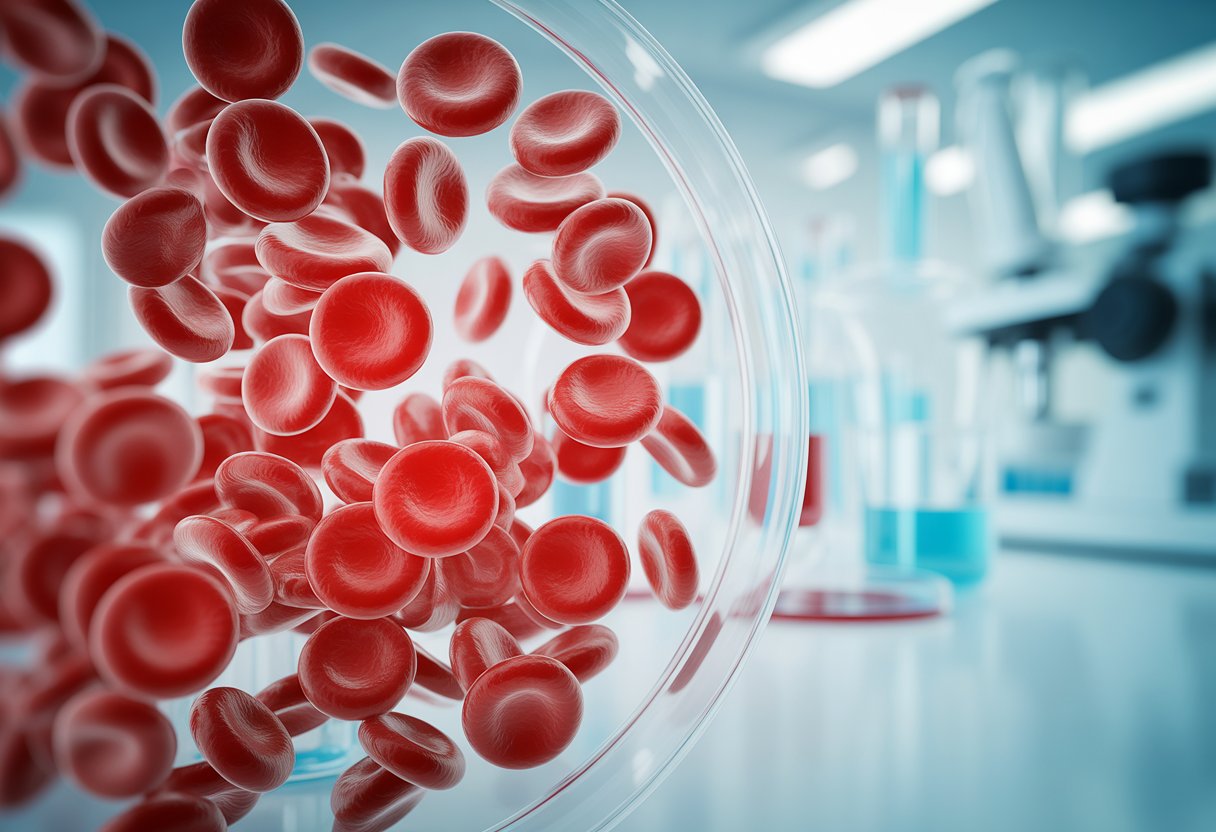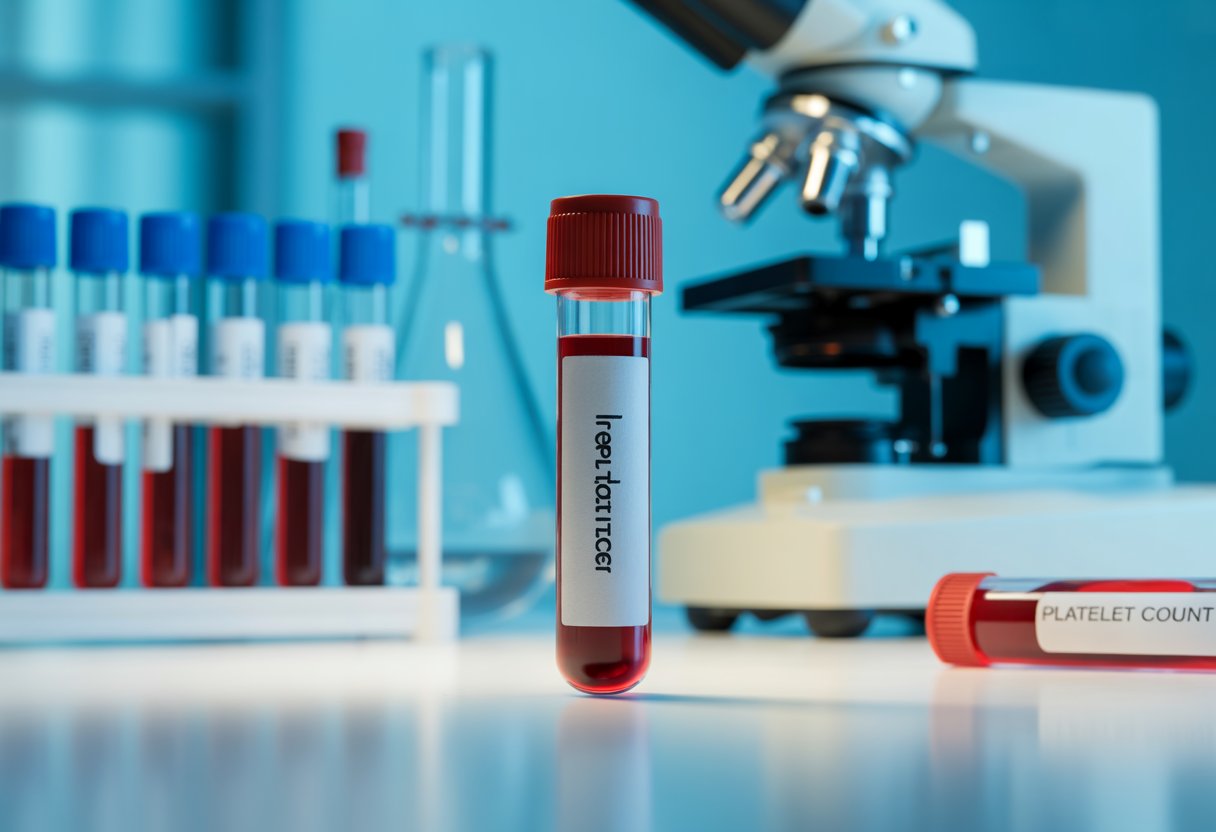A high platelet count means having more than 450,000 platelets per microliter of blood, which can make blood more likely to form clots. When platelet levels are too high, blood clots can form more easily in blood vessels, potentially leading to serious complications like heart attacks or strokes. This condition, called thrombocytosis, affects how blood flows through the body.
Many people with high platelet counts don’t experience symptoms[1], making it important to understand what causes this condition and when it becomes dangerous. The elevated platelet levels can happen for different reasons, from underlying health conditions to genetic factors.
Understanding the risks and treatment options for high platelets helps people work with their doctors to prevent complications. Learning about the causes and symptoms of thrombocytosis[2] gives patients the knowledge they need to manage their health effectively.
Key Takeaways
- High platelet counts over 450,000 per microliter increase the risk of dangerous blood clots forming in blood vessels
- Most people with elevated platelets have no symptoms, but complications can include heart attacks, strokes, and bleeding problems
- Treatment focuses on addressing underlying causes and preventing clot formation through medication and lifestyle changes
Understanding Platelets and Platelet Count

Platelets are small blood cell fragments[3] that play a crucial role in blood clotting and stopping bleeding. Normal platelet levels range from 150,000 to 450,000 per microliter of blood, and doctors measure these levels through routine blood tests.
What Are Platelets?
Platelets, also called thrombocytes, are small blood cell fragments[3] that form in the bone marrow. They circulate through the bloodstream and serve a vital function in the body’s healing process.
When a blood vessel gets damaged, platelets quickly travel to the injury site. They stick together to form a plug that helps stop bleeding. This process is called blood clotting or coagulation.
Platelets are much smaller than red and white blood cells. They have a round or oval shape and lack a nucleus. Despite their small size, they contain important substances that help with clotting.
The bone marrow produces new platelets constantly. Old platelets get removed from the blood after about 7 to 10 days. This ongoing cycle keeps platelet levels stable in healthy people.
Normal Platelet Levels
A normal platelet count ranges from about 150,000 to 450,000 platelets per microliter of blood[2]. Doctors use these numbers to determine if someone has normal, low, or high platelet levels.
Normal Platelet Count Range:
- Lower limit: 150,000 platelets per microliter
- Upper limit: 450,000 platelets per microliter
- Average range: 250,000 to 350,000 platelets per microliter
Platelet counts can vary slightly from person to person. Factors like age, gender, and overall health can affect these numbers. Women may have slightly different levels during menstruation or pregnancy.
A high platelet count occurs when levels exceed 450,000 platelets per microliter[2]. This condition is called thrombocytosis.
How Platelet Count Is Measured
Doctors measure platelet count through a complete blood count (CBC). This common blood test examines different types of blood cells, including platelets.
The CBC requires only a small blood sample, usually taken from a vein in the arm. A lab technician places the blood sample in a machine called an automated cell counter.
The machine counts the number of platelets in a specific volume of blood. Results typically come back within a few hours to a day. Most people get platelet count results as part of routine medical checkups.
CBC Test Information:
- Sample needed: Small blood draw from arm vein
- Time required: 5-10 minutes for blood draw
- Results available: Usually within 24 hours
- Preparation needed: None for platelet count
Blood tests can identify high platelet counts through routine screening[3]. Many people discover abnormal platelet levels during regular health checkups before any symptoms appear.
What Does a High Platelet Count Mean?

A high platelet count means your blood has more than 450,000 platelets per microliter. This condition splits into two main types: primary thrombocytosis caused by bone marrow problems and secondary thrombocytosis caused by other health conditions.
Definition of High Platelets (Thrombocytosis)
High platelet count, called thrombocytosis[2], happens when platelet levels rise above 450,000 platelets per microliter of blood. Normal platelet counts range from 150,000 to 400,000 per microliter.
Platelets are small blood cells made in bone marrow. They help form clots to stop bleeding when you get injured.
When high platelets occur as a result of another condition[3], doctors need to find the root cause. The extra platelets can make blood too thick. This increases the risk of dangerous blood clots.
Most people with mild thrombocytosis feel fine. Symptoms usually only appear when platelet counts get very high or when clots form.
Primary vs. Secondary High Platelets
Primary thrombocytosis happens when bone marrow makes too many platelets on its own. Essential thrombocythemia is the most common type of primary platelet disorder.
Essential thrombocytosis is a genetic condition[1] that develops during a person’s lifetime. Gene changes tell bone marrow to overproduce platelets. This type carries higher risks for serious complications.
Secondary thrombocytosis occurs when other health problems cause high platelets. Reactive thrombocytosis happens when your body reacts to a condition[1] by making extra platelets.
Common causes include:
- Infections
- Cancer
- Blood loss
- Iron deficiency anemia
- Inflammatory conditions
- Spleen removal surgery
Secondary thrombocytosis usually improves when doctors treat the underlying condition.
Causes of High Platelet Count

High platelet counts occur when the body produces too many platelets or when another condition triggers increased production. Reactive thrombocytosis develops from infections, inflammation, or other medical conditions[2], while primary causes involve bone marrow disorders that directly affect platelet production.
Reactive (Secondary) Causes
Reactive thrombocytosis happens when the body increases platelet production in response to another condition. This type accounts for most high platelet count cases.
Infections and Inflammation commonly trigger elevated platelets. Bacterial infections, viral illnesses, and inflammatory conditions like arthritis cause the immune system to boost platelet production. Inflammatory bowel disease creates chronic inflammation that keeps platelet levels high.
Cancer frequently causes secondary thrombocytosis. Ovarian cancer, lung cancer, breast cancer, and gastrointestinal cancer often present with elevated platelet counts[2]. Lymphoma also increases platelets through inflammatory processes.
Blood disorders like iron deficiency anemia and hemolytic anemia trigger high platelets. The body compensates for low red blood cells by producing more platelets. Iron deficiency anemia particularly affects women and children.
Tissue damage from trauma or severe bleeding causes temporary platelet elevation. The body responds to injury by increasing clotting factors, including platelets.
Primary (Essential) Causes
Primary thrombocytosis occurs when bone marrow produces excessive platelets without an underlying trigger. These conditions involve direct problems with blood cell production.
Essential thrombocythemia represents the most common primary cause. Genetic mutations in JAK2 and CALR genes affect bone marrow function[2]. These mutations cause uncontrolled platelet production.
Polycythemia vera increases all blood cell types, including platelets. This myeloproliferative neoplasm carries higher risks for blood clots and can progress to leukemia.
Myelofibrosis involves scarring of bone marrow tissue. The damaged marrow produces abnormal numbers of platelets and other blood cells.
These primary conditions require ongoing medical management. They often progress slowly but need regular monitoring for complications.
Influence of Medications, Surgery, and Lifestyle
Several external factors temporarily increase platelet counts through various mechanisms.
Surgical procedures commonly elevate platelets. Splenectomy particularly increases platelets in up to 90% of patients[2]. The spleen normally stores and filters platelets, so its removal causes circulation increases.
Medications can trigger drug-induced thrombocytosis:
- Heparin and epinephrine
- Certain antibiotics
- Antipsychotic drugs
- Acne medications
- Chemotherapy treatments
Lifestyle factors affect platelet production. Intense exercise releases epinephrine, which mobilizes platelets from the spleen. Chronic stress appears linked to sustained high platelet levels.
Pregnancy complications sometimes involve elevated platelets. High counts during pregnancy increase risks for blood clots, slow fetal growth, and premature delivery.
Most medication and lifestyle-related increases resolve when the trigger stops. Surgery-related elevation typically normalizes within three months.
Symptoms and Complications of High Platelet Count

Most people with high platelet counts experience no symptoms at all. When symptoms do occur, they typically involve problems with blood clotting, unusual bleeding, or general discomfort like headaches and fatigue.
Common Symptoms
Many people with high platelet counts don’t have symptoms[1]. When symptoms appear, they often include general signs of illness.
Neurological symptoms are common and include:
- Headaches
- Dizziness and lightheadedness
- Numbness in hands or feet
Physical symptoms may involve:
- Fatigue and weakness
- Pain, swelling, and redness in hands and feet
- Chest pain
- Shortness of breath
Some patients experience bleeding from the mouth or gums[1] along with frequent nosebleeds. These symptoms happen more often in essential thrombocytosis than in reactive cases.
Blood Clotting Risks
High platelet counts increase the risk of dangerous blood clots forming throughout the body. These clots can block important blood vessels.
Major clotting complications include:
- Stroke – blood clots in brain vessels
- Heart attack – clots blocking heart arteries
- Pulmonary embolism – clots traveling to the lungs
- Deep vein thrombosis – clots in leg veins
Clots can form in other places too, like the lungs and legs[1]. The biggest concern is that these clots can lead to life-threatening events.
Blood clots cause serious problems when they block blood flow to vital organs. Essential thrombocytosis carries higher clotting risks than reactive cases.
Bleeding and Bruising Concerns
Despite having too many platelets, some people experience unusual bleeding problems. This seems contradictory but happens when platelets don’t work properly.
Common bleeding issues include:
- Easy bruising from minor bumps
- Frequent nosebleeds
- Bleeding gums during tooth brushing
- Heavy menstrual periods in women
Bruising easily and bleeding from the mouth[1] are typical signs. These bleeding problems occur when the excess platelets interfere with normal clotting.
The bleeding usually involves minor episodes rather than serious hemorrhages. However, any unusual bleeding patterns should be reported to a doctor promptly.
Diagnosis and Evaluation

Doctors use blood tests to see why you have too many platelets[4] and sometimes need bone marrow samples for further testing. The process involves checking platelet levels, looking for underlying conditions, and ruling out serious causes.
Initial Blood Tests
The first step involves a complete blood count (CBC) to confirm high platelet levels. Normal platelet counts range from 150,000 to 400,000 per microliter of blood.
High platelet count is diagnosed when levels exceed 450,000 platelets per microliter[2]. The CBC also shows other blood cell counts that help doctors understand the cause.
Doctors repeat the blood test to make sure the high count is real. Sometimes lab errors or temporary conditions can cause false results.
The CBC reveals if other blood cells are also abnormal. This information helps doctors tell the difference between different types of high platelet conditions.
Additional Diagnostic Procedures
Iron studies check if low iron levels are causing high platelets. Iron deficiency anemia often leads to increased platelet production.
Inflammatory markers like erythrocyte sedimentation rate and C-reactive protein show if inflammation is the cause. These tests help find infections or inflammatory diseases.
Doctors may order a bone marrow biopsy if they suspect essential thrombocytosis. This procedure takes a small sample of bone marrow to examine how platelets are made.
Genetic testing looks for mutations that cause essential thrombocytosis. Specific gene changes like JAK2, CALR, and MPL mutations help confirm the diagnosis.
Assessing Underlying Conditions
Doctors look for conditions that can cause reactive thrombocytosis. Cancer, infections, and inflammatory diseases are common causes that need treatment.
Physical exams check for enlarged spleen or liver. These organs can affect platelet production and removal from the blood.
Medical history reveals recent surgeries, medications, or illnesses that might explain high platelets. Blood loss and certain drugs can trigger increased platelet production.
Imaging tests like CT scans may be needed to find hidden cancers or infections. These conditions often cause the body to react by making too many platelets[1].
Treatment and Management Options

Treatment for high platelet counts focuses on reducing complications and addressing root causes. Doctors may prescribe specific medications to lower platelet production or recommend lifestyle changes based on individual needs.
Treating the Underlying Cause
Doctors first identify what causes the high platelet count. If an infection triggers the problem, treating the infection often brings platelet levels back to normal.
Cancer patients may see their platelet counts drop once they receive proper cancer treatment. People with inflammatory conditions like arthritis need treatment for the inflammation itself.
Some patients have essential thrombocythemia, where bone marrow makes too many platelets without an obvious cause. This condition requires different treatment approaches than secondary causes.
Blood tests help doctors track whether treating the underlying condition improves platelet levels. Regular monitoring shows if additional treatments are needed.
Medications and Therapies
Several medications can reduce platelet production in the bone marrow. Anagrelide works as a platelet reducing agent[5] for people with severely high counts.
Hydroxyurea is another common medication that slows down platelet production. Doctors often prescribe this for patients with essential thrombocythemia or other platelet disorders.
Interferon-alpha helps some patients by reducing the bone marrow’s ability to make excess platelets. This medication works well for younger patients who need long-term treatment.
Low-dose aspirin prevents blood clots in many patients with high platelet counts. This simple medication reduces the risk of heart attacks and strokes.
In rare cases, doctors may recommend spleen removal if other treatments fail and the spleen destroys too many platelets.
Lifestyle Changes and Monitoring
Patients need regular blood tests to check their platelet count levels. Most people get tested every few months to make sure treatments work properly.
Staying hydrated helps prevent blood from becoming too thick. Drinking plenty of water throughout the day supports healthy blood flow.
Exercise improves circulation and helps prevent blood clots. Walking, swimming, and other moderate activities benefit most patients with high platelet counts.
Patients should avoid activities that increase bleeding risk when platelet counts are very high. This includes contact sports and activities that could cause injuries.
Some people need to limit foods high in vitamin K, which affects blood clotting. Doctors provide specific dietary guidance based on individual medication needs.
Outlook and Preventing Complications

Most people with high platelet counts have good outcomes, especially when the underlying cause gets proper treatment. The key is getting regular medical care and watching for signs of serious problems like blood clots.
Prognosis for High Platelet Count
The outlook for high platelet count depends on what caused it. People with reactive thrombocytosis usually do well once doctors treat the underlying condition.
Reactive thrombocytosis often goes away when the cause gets fixed. This might be treating an infection, managing inflammation, or fixing iron deficiency.
Essential thrombocytosis has a more complex outlook. Most people live normal lives with proper treatment. However, complications are more common with essential thrombocytosis[1] than reactive types.
Key risks include:
- Blood clots leading to stroke or heart attack
- Problems during pregnancy, including miscarriage
- Rare transformation to leukemia
- Bone marrow scarring
Regular blood tests help doctors track platelet count changes. Many people need lifelong monitoring even when feeling fine.
When to Seek Medical Help
People should contact their doctor right away if they notice certain warning signs. Quick action can prevent serious complications.
Call your doctor immediately for:
- Severe headaches or dizziness
- Chest pain or trouble breathing
- Sudden weakness on one side of the body
- Vision changes or slurred speech
- Severe belly pain
- Unusual bleeding that won’t stop
Regular check-ups matter for:
- Monitoring platelet levels
- Adjusting medications
- Screening for complications
- Managing other health conditions
Pregnant women with high platelet count need extra care. They face higher risks of miscarriage and blood clots. Close monitoring throughout pregnancy helps protect both mother and baby.
People taking blood thinners need regular blood work. This ensures the medication works properly without causing dangerous bleeding.
Frequently Asked Questions

High platelet counts affect people differently based on age, gender, and underlying health conditions. Treatment approaches vary from simple monitoring to medication, while certain symptoms may signal more serious conditions requiring immediate medical attention.
What are the typical symptoms associated with a high platelet count in females?
Women with high platelet counts may experience easy bruising and bleeding[2] more frequently than men. Heavy menstrual periods can become more common or severe.
Blood clots may form in the hands, feet, or brain. These clots can cause headaches, dizziness, and weakness.
Some women develop erythromelalgia, which causes pain, swelling, and redness in the hands and feet. Nosebleeds and bleeding gums may also occur more often.
What are common treatments for managing thrombocytosis?
Doctors often prescribe low-dose aspirin daily to prevent blood clots from forming. This treatment works well for many patients with mild symptoms.
Medications like hydroxyurea and anagrelide help suppress platelet production in the bone marrow[6]. These drugs reduce the number of platelets the body makes.
Some patients need no treatment if they have no symptoms. Regular checkups allow doctors to monitor platelet levels over time.
In rare cases, doctors may recommend splenectomy. This surgery removes the spleen to reduce platelet destruction.
How may a high platelet count be indicative of cancer, and what symptoms should be noted?
Blood cancers like leukemia and lymphoma can cause platelet counts to rise. These cancers affect how the bone marrow produces blood cells.
Swollen lymph nodes may appear in the neck, armpits, or groin. Unexplained weight loss and persistent fatigue are common warning signs.
Night sweats and fever without infection may occur. Severe bleeding even from minor injuries can signal blood cancer.
Easy bruising that appears without cause needs medical attention. Persistent weakness combined with high platelets requires immediate evaluation.
At what threshold of platelet count is a medical evaluation recommended?
Platelet counts above 450,000 per microliter of blood[6] require medical evaluation. Normal platelet counts range from 150,000 to 450,000 per microliter.
Any symptoms like unusual bleeding or clotting need immediate attention regardless of platelet count. Headaches, dizziness, or vision changes also warrant evaluation.
Doctors may investigate counts between 400,000 and 450,000 if patients have symptoms. Multiple high readings over time are more concerning than single elevated tests.
What are the potential causes of a slightly elevated platelet count?
Recent infections can temporarily raise platelet counts as the body responds to illness. Bacterial and viral infections commonly cause this reaction.
Surgery or trauma triggers the body to produce more platelets for healing. This type of elevation usually returns to normal within weeks.
Inflammatory conditions like rheumatoid arthritis can elevate platelets. Iron deficiency anemia also causes reactive increases in platelet production.
Some medications used for seizures or heart conditions may raise platelet counts. Cancer treatments can also affect platelet levels temporarily.
What are the guidelines regarding high platelet counts in children that require medical attention?
Children with platelet counts above 450,000 per microliter need medical evaluation. Pediatric normal ranges are similar to adult values.
Infections cause most high platelet counts in children and usually resolve on their own. Persistent elevation after infection clears requires further testing.
Blood cancers in children may present with high platelets along with other symptoms. Easy bruising, pale skin, or enlarged lymph nodes need immediate attention.
Genetic testing may be necessary if children have extremely high counts without obvious causes. Family history of blood disorders increases concern for inherited conditions.
References
- Thrombocytosis: Symptoms, Causes & Treatment. https://my.clevelandclinic.org/health/diseases/13350-thrombocytosis Accessed November 3, 2025
- the causes and symptoms of thrombocytosis. https://www.verywellhealth.com/when-to-worry-about-high-platelet-count-5186732 Accessed November 3, 2025
- High Platelets and Thrombocytosis: Symptoms, Causes, and More. https://resources.healthgrades.com/right-care/blood-conditions/high-platelets Accessed November 3, 2025
- Quick Facts:High Platelet Count. https://www.msdmanuals.com/home/quick-facts-blood-disorders/myeloproliferative-disorders/high-platelet-count Accessed November 3, 2025
- What are the treatment options for thrombocytosis (elevated platelet count)?. https://www.droracle.ai/articles/143808/what-can-high-platelet-cause Accessed November 3, 2025
- What's It Mean If Your Platelet Count Is High? Thrombocytosis. https://www.medicinenet.com/what_does_it_mean_if_your_platelet_count_is_high/article.htm Accessed November 3, 2025
